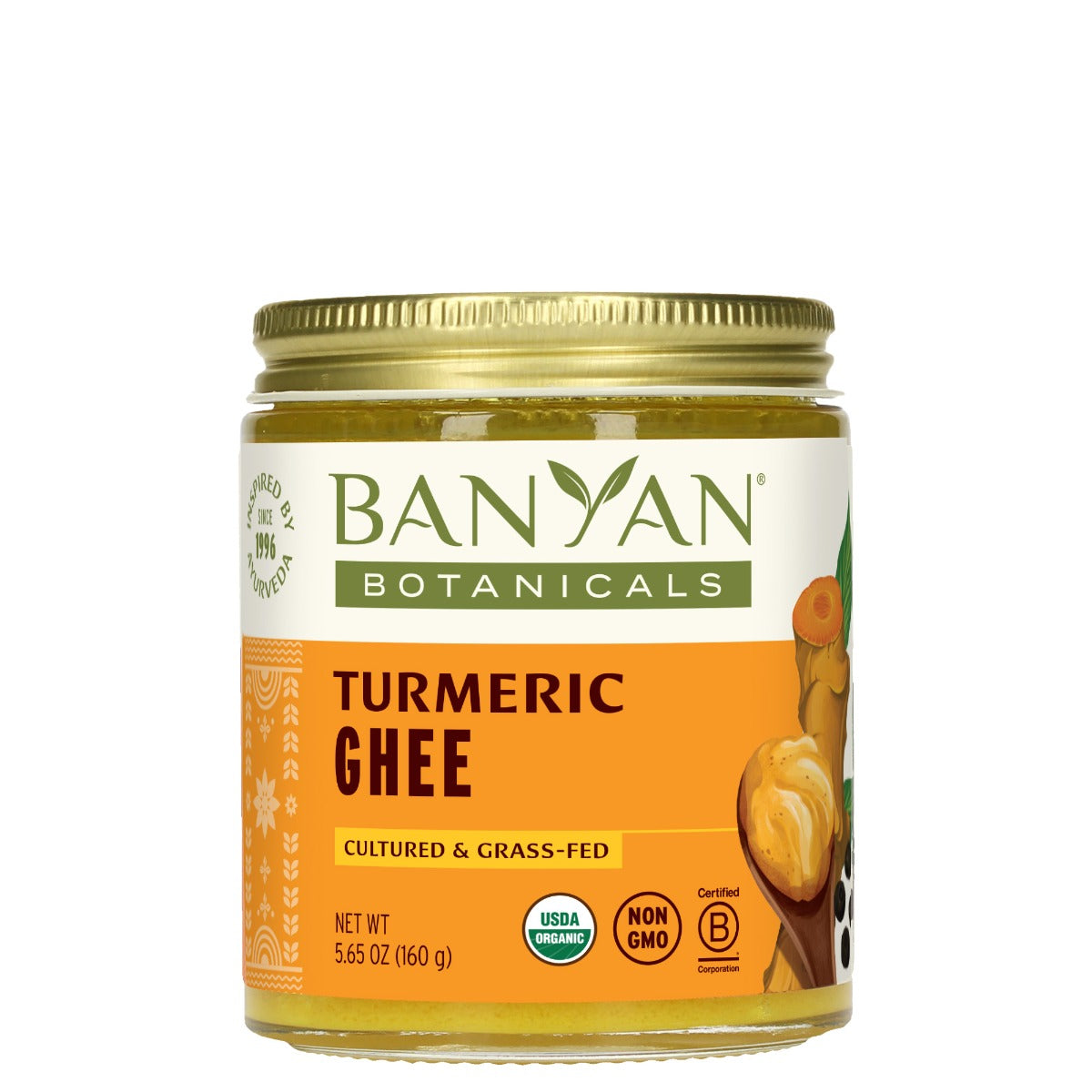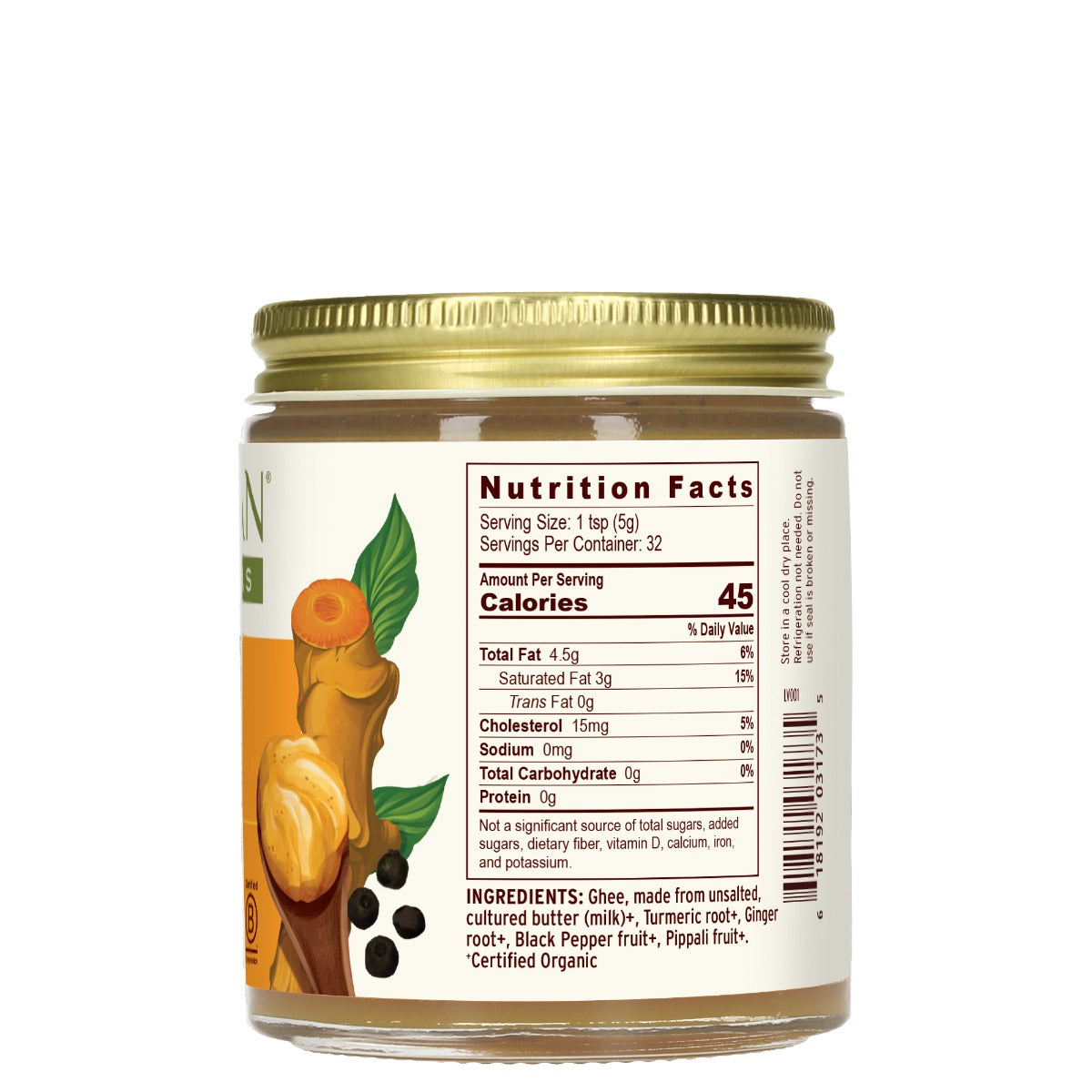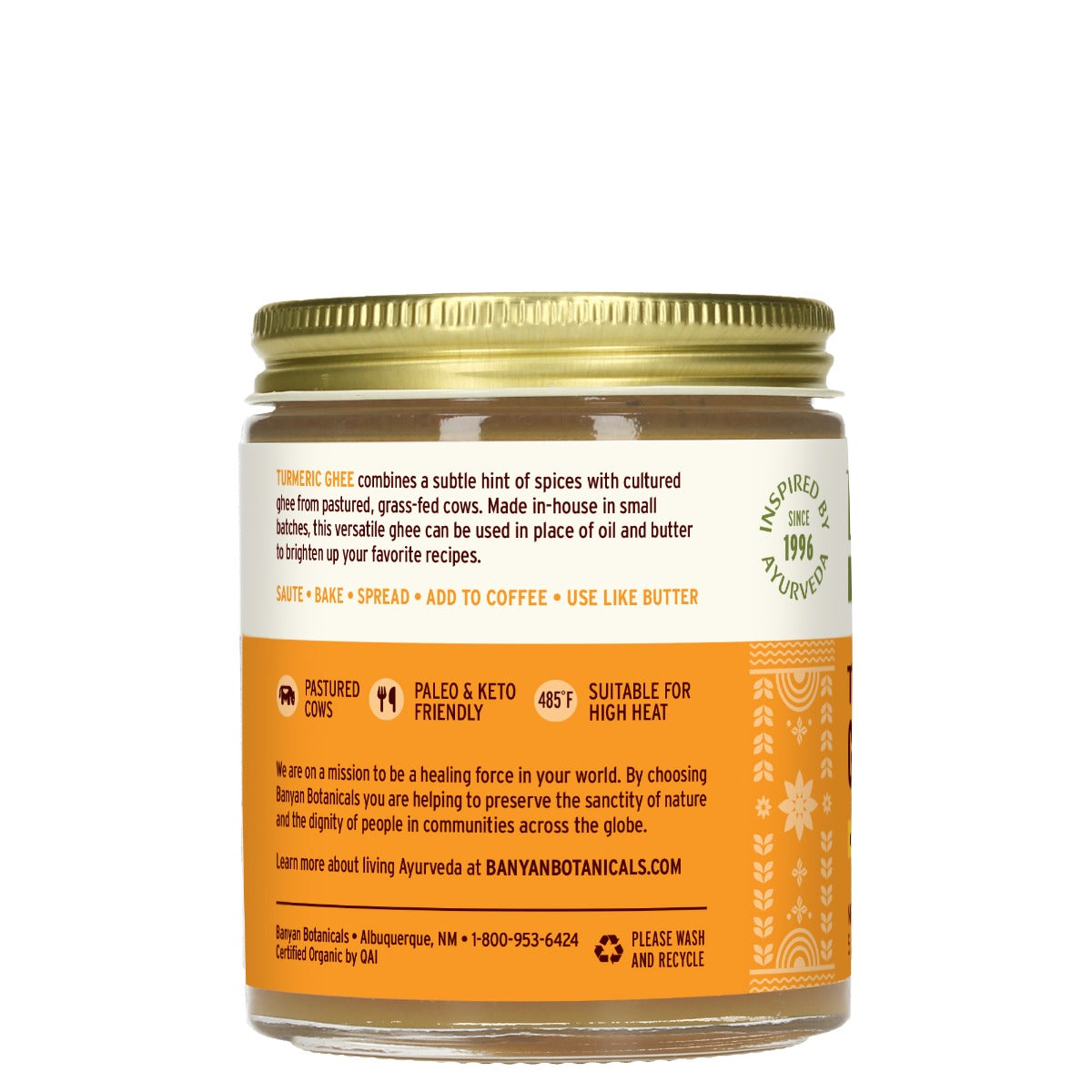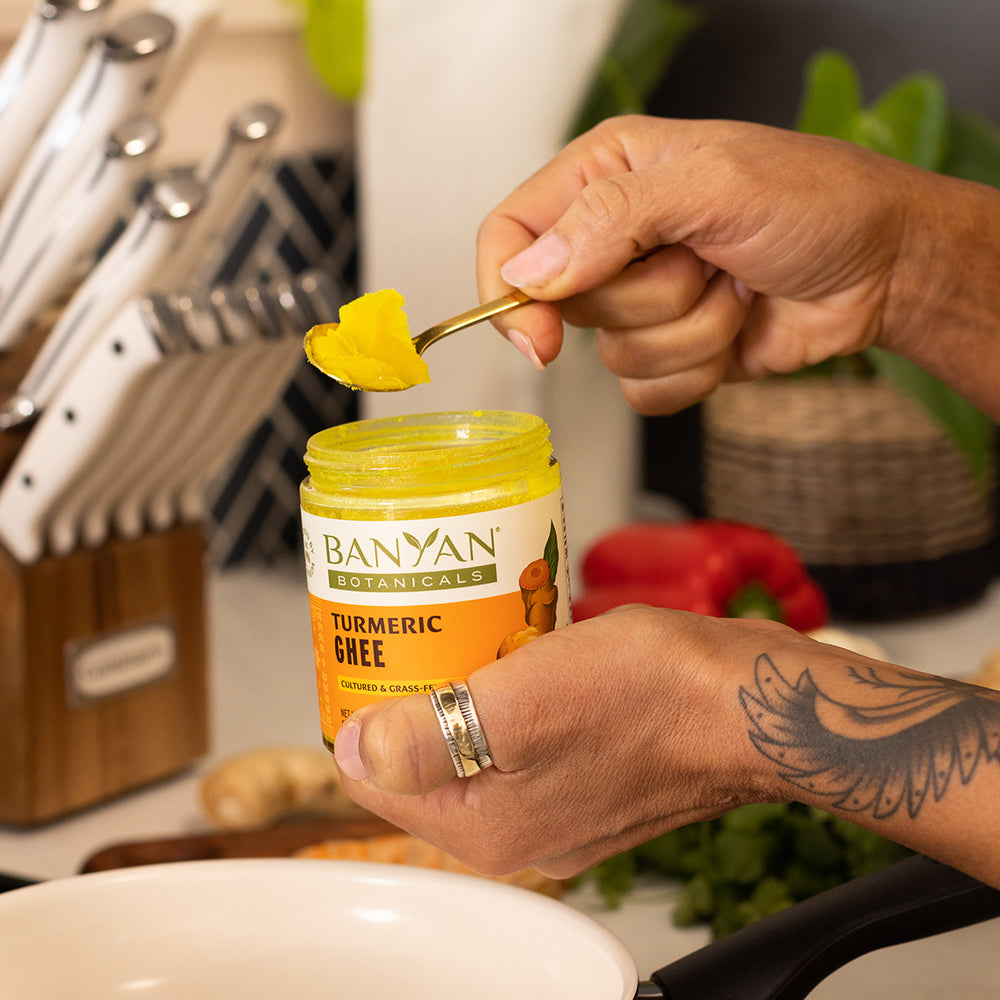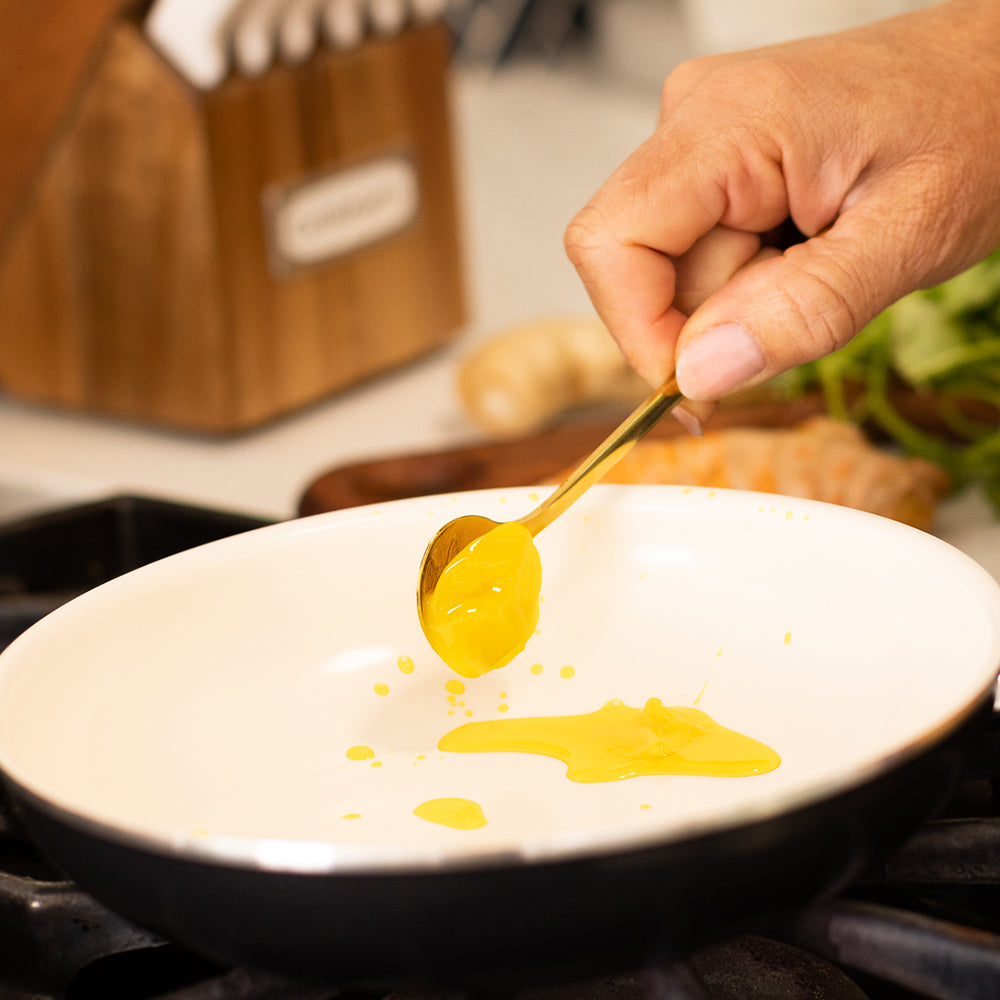Turmeric Ghee
Turmeric Ghee
20% Off | Code: CLEANSE20
Couldn't load pickup availability
Free Shipping on Orders Over $60
Satisfaction Guarantee - 90 Day Return Policy
About Turmeric Ghee
About Turmeric Ghee
Turmeric Ghee combines a subtle hint of spices with creamy cultured ghee from grass-fed cows in a delicate symphony of flavors. Made in-house in small batches, this savory flavored ghee is versatile and delicious. Use it in place of oil and butter to spice up your favorite recipes.
- Cultured ghee from pastured, grass-fed cows
- Lightly spiced with turmeric and pippali
- Suitable for high heat
- Use like butter or oil
How To Use
How To Use
Ways to Enjoy Turmeric Ghee:
- Use as a spread on toast and baked goods
- Drizzle over popcorn and sautéed veggies
- Add to soups, stews, and curries
- Mix into coffee for sustained energy
Ingredients
Ingredients
Serving size: 1 teaspoon
Servings per container: 32
Ingredients:
Ghee, made from unsalted, cultured butter (milk)+, Turmeric root+, Ginger root+, Pippali fruit+, Black Pepper fruit+.
+Certified Organic
This item is suitable for vegetarians.
It is normal for the texture of this ghee to vary slightly. This does not impact the taste, quality, or shelf life.
- "I use it for almost everything, The classics as in Indian dishes but also in fried potatoes, pasta sauce and many more" —Anna J.
- "It’s subtle enough that I add it to everything savory but flavorful enough that it really adds a nice flavor plus gives a good dose of turmeric!!" —Megan

MAKING TURMERIC GHEE
Turmeric Ghee starts with a creamy base of our rich, pure ghee that we hand make in small batches from the finest cultured butter from grass-fed and pasture-raised cows. From there, we add a blend of earthy golden turmeric and a hint of warm spices, including ginger, pippali, and black pepper. The result is a creamy, subtly spiced blend to enhance your kitchen creations and nourish your well-being.

-

Cruelty Free
-

Gluten Free
-

Non Gmo

DELICIOUS & VERSATILE
This subtly spiced ghee can be used for cooking, baking, or as a simple topping to incorporate a natural source of high-quality fat into your daily diet. Enjoy it on top of soups, stews, or kitchari, or spread a layer on top of toast or baked goods. It makes a delicious golden drizzle for popcorn, a tasty base for sauces and dressings, and a luscious addition to warm drinks.

Turmeric Ghee FAQs
Our ghees are made in-house in small batches and are organic, sustainably sourced, and fairly traded.
- What gives ghee its golden color?
- What does Banyan's ghee smell like?
- What is the culturing process for the butter used to make this ghee?
- What is the benefit of using cultured butter to make the ghee?Â
- Why does the texture vary?
- The texture of my ghee is liquid or semi-liquid. How do I make my ghee solid and creamy?
- Do I need to refrigerate ghee?
- How do I know if ghee has gone bad?
1. What gives ghee its golden color?
The rich golden yellow color of ghee comes from a compound called beta-carotene. This carotenoid pigment comes from the cows' diet, which consists primarily of grass, dried grass, grains, and cereals. This golden color can vary depending on seasonal changes and the abundance of lush green grass that the cows graze upon.Â
2. What does Banyan's ghee smell like?
Our original ghee has a mild, sweet, and slightly nutty aroma, which comes from the cultured butter we use.
3. What is the culturing process for the butter used to make this ghee?
In traditional Ayurveda, the first step for making ghee starts with a process called “culturing.” Bacterial cultures are added to cow's milk and churned to make butter cream. The butter is then cooked until all the water is removed to form clarified butter, or ghee.
4. What is the benefit of using cultured butter to make the ghee?
Cultured butter is considered to be easier to digest and more balancing to all three doshas, including kapha. It also gives the ghee a unique nutty flavor.
Ghee contains many fatty acids that have different melting points, which can make the texture vary. This is caused by the melting and crystallization of the fats as the temperature and conditions change during production, storage, or transit. While this can change the texture, it does not impact the taste, quality, and shelf life of the ghee.
6. The texture of my ghee is liquid or semi-liquid. How do I make my ghee solid and creamy?
You have two options:
Simply place the ghee jar in a hot water bath for about 5·10 minutes until you notice the ghee turn completely liquid, then remove and let it cool. This may seem counterintuitive if it's already in a liquid or semi-liquid state, but it's the cooling process that matters!
Another option is to refrigerate the ghee jar overnight or leave the jar on the counter for the night. If you choose to leave it on the counter, you may notice a granulated texture. If you don't want this, we suggest refrigerating.
7. Do I need to refrigerate ghee?
While you can refrigerate ghee, it can also be stored in your cupboard. Keep it cool, out of sunlight, and free of any water or contaminants.
8. How do I know if ghee has gone bad?
The smell and color will let you know. It will smell rancid or sour. Original, unspiced ghee will turn white, and both the original and spiced ghee will form black spots on the top layer.Â

-
Sustainably Sourced
Environmentally responsible practices support the long term well-being of the plants and ecosystems we source from.
-
Certified Organic
Organic herbs are grown with the use of renewable resources, contributing to both individual and planetary health.
-
Fairly Traded
Equitable supply chains ensure the social and economic well-being of our small farmers, producers, and suppliers.












